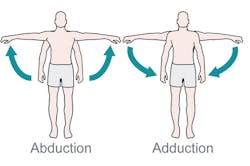What’s the Difference Between Abduction and Adduction? (Biomechanics)
Editor's Note: An updated version of this information can be found here.
In medicine and biomechanics, movements of limbs and other body parts toward or away from the center line of the body (a line that runs up and down the center of the human body) are termed adduction and abduction, respectively.
Adduction is the movement of a body part toward the body’s midline. So, if a person has their arms straight out at the shoulders and brings them down to their sides, it is adduction. For fingers or toes, adduction brings the digits toward the center of the hand or foot. For example, if a person has their fingers spread wide apart, bringing them together would be adduction. Closing arms to the chest or bringing knees together are other examples of adduction. Adduction of the wrist, moving a hand toward the body at the wrist when that arm is at the person’s side, is also called ulnar deviation. Any muscle that creates this type of motion is called an adductor.
For normal eyes (not cross-eyed, for example) when the right is adducted, it moves toward the center of the face and looks left. At the same time, the left eye is abducted, moving away from the midline of the face and looking left. So in people with normal eyes, when one eye is adducted, the other abducts.
Abduction is any motion of the limbs or other body parts that pulls away from the midline of the body. Swinging the hands from the side of the body up to the shoulder or higher is abduction. For fingers and toes, abduction spreads the digits away from the hand or foot’s centerline of hand or foot. Raising the arms laterally, to the sides and moving the knees away from the midline are some examples of abduction. Abduction of the wrist, moving the hand away from the body at the wrist when that arm is at the person’s side, is called radial deviation. Any muscle that creates this type of motion is termed an abductor.

